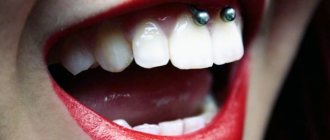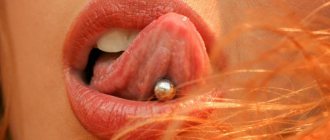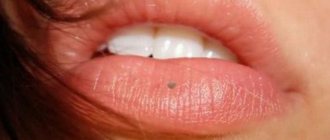There are many ways to show your individuality. An extraordinary hairstyle or original hair color, unusual clothes or tattoos, bright accessories and an informal appearance. Lip piercing is one of the methods of showing individuality and uniqueness. Needless to say that lip piercing is common in both sexes?
Where can you pierce your lip, which side should you pierce your lip on, how to care for your lip piercing?
It is worth noting that it is necessary to take care of such piercings in a certain way. The fact is that this area heals quite quickly, but can cause a number of complications in the form of suppuration, abscesses and redness.
How to care for your lip piercing:
- This especially often happens if the piercing is performed in the oral cavity or involving it. That is, when one part of the decoration is in the mouth. Thus, the metal can oxidize under the influence of food and various drinks.
- As a result of this, oxidation products negatively affect the condition of the skin and mucous membranes. Stomatitis, damage to tooth enamel, as well as inflammation and suppuration can often occur.
- To prevent this from happening, several times a day, after the puncture, it is necessary to rinse with antiseptics that do not contain alcohol. That is, it is Miramistin, Chlorhexidine or Furacilin.
- In case of suppuration, pulling ointments with antibiotics are used. Often, experts prescribe special rinsing solutions that are used in the treatment of stomatitis, as well as thrush and inflammation in the mouth. These include Hepilor, Stomatidin, and Givalex. All these solutions contain astringents, as well as antiseptics, which help fight bacterial microflora and prevent the growth of infection, inflammation and suppuration.
Decorations
Contraindications
Any body art carries a certain health risk. There are some contraindications for piercing. First of all, these are herpes and other skin diseases. It is not recommended to pierce the skin during colds.
Lip piercing inflammation
Other contraindications for piercing:
- Pregnancy. This is not a categorical requirement, but during lactation and during an “interesting” position, interventions in the body are not recommended;
- Blood diseases. If the piercing should heal, the reason lies in the composition of the blood. If platelet formation time is short or other diseases occur, it is recommended to remove the jewelry;
- It should not be done with any reduced immunity.
The main consequences that lip piercing owners face are swelling, suppuration or infection. If a girl’s piercing has festered, she needs to remove the jewelry, apply an antiseptic compress to the wound and take more careful care of the hole.
But, sometimes, inflammatory processes begin not because of improper care, but because of the wrong material of the piercing jewelry or the weight of the earring. For example, if the labrette is too heavy, it can pull on the skin and interfere with normal healing. In this case, you need to change the decor to gold or silver, but thinner and lighter.
Consequences of lip piercing
It is worth noting that beauty requires sacrifice, this applies to piercing in the oral cavity. Lack of proper treatment or incorrectly chosen puncture site can lead to disastrous consequences.
Consequences of lip and oral cavity piercing:
- Infection. A lot of pathogenic and opportunistic microorganisms live in the mouth, which can infect a wound and become an entry point for some kind of infection.
- Bleeding. This does not always happen; most often the punctures pass without a large amount of blood. Bleeding can only occur if the area of a blood vessel is affected.
- Painful sensations and swelling. Indeed, when performing a puncture, unpleasant sensations can often occur. Swelling is a common reaction and is a variant of the norm. However, for severe swelling, it is necessary to use decongestants, as well as hormonal agents and corticosteroids, which relieve inflammation and reduce swelling.
- The presence of chips on the teeth. Incorrectly selected jewelry, as well as constant friction in this area, leads to the appearance of cracks. Very often scratches occur on restored teeth that have crowns on them.
- Damage and gum disease. With improper care, gums often become infected and damaged by jewelry.
- Impaired pronunciation of certain sounds. Indeed, when talking and having earrings in an inconvenient place, difficulties may be observed, as well as diction disturbances that were not there before.
- Infection with hepatitis b, c, d. Indeed, there are many options for contracting hepatitis directly through piercings and tattoos. Therefore, choose a proven salon with positive reviews that uses only disposable tools.
Beautiful punctures
There are things to think about
Yes, a pierced lip looks quite unusual. However, before you dare to take this step, you should pay attention to some nuances that, quite possibly, will make you change your mind or postpone going to the salon for an indefinite time:
- Medical indicators. Even simple rashes during a seasonal exacerbation of ARVI can become the No. 1 reason that does not allow getting a piercing under the lip. Eczema, diabetes, epilepsy, pregnancy and lactation, as well as allergies to metals - all of these are serious medical contraindications that prevent piercing. It is also better for girls during menstruation to refrain from going to the salon for a while.
- Appropriate dress code. Do not forget that piercing is a clear manifestation of informal style. If a girl or guy works in a reputable company where business negotiations are often required, piercing will make a negative impression on the interlocutor.
- Competent choice of master and salon. This is where it gets serious – this issue should be approached with special care. The lack of a license and certificate is a sign that this place should be avoided.
Interesting: Eyebrow piercing: how the piercing is done, types. Care and selection of decoration
Many people are shy in front of the salon door, fearing that the procedure will be painful. In fact, piercing the upper or lower lip is not as scary as it seems at first glance. If you evaluate the painful sensations during the process of creating a piercing, you can give 6 points out of a possible 10.
In addition, a lip piercing heals very quickly - the tissue in the mouth area is soft and thin, devoid of blood vessels and capillaries. This means that the experience of a professional master will allow you to quickly and efficiently complete the procedure.
Does lip piercing hurt?
Painful sensations depend on the individual characteristics of the body and the sensitivity of the person.
Does lip piercing hurt?
- Experts have noticed that it hurts the most for people who have fairly thick, lush, dense lips and a decent thickness of skin. Therefore, punctures are much more painful than those with thin lips. The most painless areas are the upper and lower frenulum. That is, this is a smiley piercing.
- All punctures that are carried out directly completely, that is, the mucous membrane and the outer part of the skin, are quite painful.
- In order to prevent the puncture from moving, special forceps are often used. Pistols are not used to carry out punctures. Mostly needles are used.
Decoration
Lip piercing is a great opportunity to decorate your appearance and make it special. However, it is worth taking into account all complications, as well as the possibility of infection.
How does the procedure work?
Installing a lip piercing consists of the following steps:
- Cotton swabs are placed in the area of the salivary gland ducts to reduce salivation.
- The puncture site is carefully treated with an antiseptic.
- The lip is fixed in a comfortable position using special clamps.
- If the client wishes and there are no contraindications, the lip can be treated with a local anesthetic (lidocaine, less often - slight cooling of the future puncture site).
- The puncture is performed at a right angle using a special needle.
- A temporary labret is placed at the puncture site.
After completing the procedure, external treatment of the puncture with peroxide and rinsing the mouth with Miramistin is mandatory. This will significantly reduce the risk of infection getting into the wound and speed up its healing.
The cost of the procedure is small, depending on the complexity, it ranges from 600 to 2500 rubles.
Flaws
What disadvantages of lip piercing should you be prepared for in advance:
- many contraindications;
- the salon procedure is not available until the age of 18, although it is possible from 16, but only in the presence and with the permission of the parents;
- very dangerous consequences of infection (HIV, sepsis, meningitis, etc.);
- decreased sensitivity of the lips;
- diction is impaired;
- after healing, a scar remains, and it is no longer possible to puncture again in the same place;
- inconvenience and discomfort when eating and kissing;
- Not all companies, due to their dress code, allow their employees to wear such extreme jewelry;
- The attitude of most people around me towards pierced lips is very negative.
You won’t have to deal with all of these troubles, but if you read the reviews, these shortcomings are some of the most common.
Types of jewelry
More detailed article: Jewelry for piercing.
- A barbell is a rod with a decoration on one end and a ball on the other. A straight rod is called a barbela, with a slightly curved rod called a navela (or “banana”). Rods vary in size - diameter, length and thickness of the rod.
- A ring is a rod bent into a circle, closed at the ends by a ball.
- A semiring, or horseshoe, is a rod bent in a semicircle with balls at both ends.
- Labret, labret (English labret, comes from the Latin labrum - lip) - a rod with a twist-off ball and a fixed tip-hat. The length of the labret can vary from 6 to 20 mm, the diameter is on average 1.6 mm. Microlabrets are distinguished by a thinner rod - 1-1.2 mm. The term “labret” also refers to the lower lip piercing itself.
- Twist is a half-ring-spiral with balls twisting at the ends.
- The tunnel is a hollow tube with small sides. Installing a tunnel is a complex type of piercing, since expanding the diameter of the puncture to the desired size is carried out gradually, in several stages.
What material should you choose for your decoration?
- At first, it is recommended to use simple jewelry - labrets or rings without stones or other frills. Materials: surgical implantation titanium, hypoallergenic plastic or Teflon, niobium, 585 or 750 gold.
- Products made from surgical steel, contrary to popular belief, are better not to be used for primary piercings, since the nickel content in it exceeds the norm, which is dangerous if it comes into contact with blood and lymph.
- After the wound has completely healed - in about a month - you can replace the jewelry with one you like, made from any high-quality hypoallergenic material that has good biocompatibility with human tissue. For example, gold, silver, titanium, zirconium, Teflon, acrylic, amber, wood, niobium and much more, including ivory
.
Who should do the piercing and with what?
Despite the apparent simplicity of the piercing procedure (“it’s just a piercing, anyone can do it”), you should take it seriously. Thus, having a medical education or a cosmetologist certificate is not a good enough reason for trust. It is safest to go to a specialized piercing salon with a valid medical license. The piercer must have work experience and a portfolio.
Turning to self-taught people who receive treatment at home or in other places unsuitable for the procedure and who do not have sufficient knowledge about the anatomy of punctures means acting at your own peril and risk. In addition, if you do not trust the master fully and cannot relax, then the pain from the puncture will be felt much more strongly.
What you need to pay attention to when visiting a specialist:
- disposable needles are used for puncture;
- instruments are sterile, i.e. In front of the client, they are taken out of an autoclave, ultraviolet cabinet or dry heater in a sealed craft bag;
- The master works in clean disposable gloves.
The safest instrument for puncture is a catheter needle (hollow inside). Piercers usually do not use a gun for piercing. It can be used only for the simplest punctures, such as the earlobes or the wings of the nose. The disadvantages include the impossibility of sterilization due to plastic components and a limited selection of compatible jewelry.
Requirements for the master and salon
A piercing salon must have:
- a general license to provide cosmetology services, confirming the right to engage in this type of activity;
- medical certificates.
The piercer (piercer) is obliged to:
- undergo appropriate training;
- have a medical record;
- be certified by the APP (Association of Professional Piercers).
When purchasing piercing jewelry, you need to check:
- certificate of conformity;
- sanitary and epidemiological conclusion;
- description of hygienic characteristics of products.
Possible complications and consequences
Piercing is a process that grossly violates the integrity of the skin, which over time can lead to certain complications for its owner.
In addition to the obvious potential danger of infection when piercing a hole in the lip for an earring, common undesirable consequences also include:
- significant damage to tooth enamel, leading to increased sensitivity and, as a result, tooth destruction;
- the occurrence of allergic reactions, the initiator of which may be the material used in the production of jewelry, a non-sterile needle or a solution for disinfecting the puncture site;
- incorrect “fusion” of holes for earrings. Unfortunately, such a consequence is extremely common among “beginners” who pierce their lips and others. It is worth emphasizing that when faced with the described fact, only surgical intervention can correct the situation. Accordingly, it is necessary to carefully choose “your” master, who has extensive experience and a serious approach to business;
- damage to secondary nerve endings, resulting in particular in the “death” of receptors responsible for recognizing the temperature of a dish or even its taste.
Types of lip piercing
There are quite a lot of piercing options, and this also includes piercings made near the lips. Classification is made according to the puncture site and the type of jewelry supplied. There are the following types of piercing:
Labret. This is a piercing of the lower lip in the middle, at the level of the teeth and below the gum level. The name comes from the name of the decoration used.
Horizontal labret. Here the earring, usually a microbanana, is placed horizontally in the center of the lower lip. It is considered quite painful and dangerous, since the wrong choice of puncture depth leads to severe inflammation and rejection by the body or too long healing. Requires especially careful care and careful wearing.
Vertical labret (estrum). For this option, the needle is passed through the border of the lower lip, exiting from the top in the center. In this case, the decoration (microbanana, spiral or ring) should not touch the gum, therefore it is located above its level. This is a safe and fast-healing option, which, however, leaves noticeable marks after removal, which take quite a long time to heal and not completely.
Ashley. It is made exactly in the center of the lower lip, with one of the ends of the decoration located inside the oral cavity. An amazingly beautiful, but equally painful and difficult to heal type of puncture. After removal, large scars remain in the lip. Recently, unusual and elegant wrappers for labrets that imitate precious stones have been used.
It is analogous to a vertical labret for the upper lip. Micro bananas are also used.
Frenum piercing. If a piercing is made on the frenulum of the upper lip, then the puncture is called a “smile”, and if the lower lip is pierced, it is called an “anti-smile”. One of the most painless and quickly growing options. Popular when doing it yourself at home. It must be taken into account that it is not visible with closed lips. It is recommended not to use metal jewelry, which hits the teeth and harms enamel, but silicone jewelry. This can be a ring, including a segmented one, or a circular one.
Often, not single punctures are used, but combinations of them, usually arranged symmetrically and in a certain order. Such combinations are called bites.
Dahlia bite
This is an equally spaced piercing in the corners of the lips. Labrets with various twists are used as decorations. It looks very unusual, giving the owner a certain charm.
Spider bite
It consists of a pair of punctures located next to each other on the side of the lower lip. Can be located on either side of the mouth. Usually rings are inserted into the holes.
Snake bite
It is obtained by piercing the skin under the lower lip on both sides of the mouth. Rings and twisters are chosen for wearing.
Angel bite
This is a double-sided piercing above the upper lip, decorated with labrets.
Shark bite
It consists of two paired punctures under the border of the lower lip, located symmetrically to each other. Segmented rings look good.
Dolphin bite
It is performed using two adjacent piercings under the lips, which are made alternately along a horizontal line. Allows you to emphasize your chin.
We should also consider such classic types of lip piercings as:
- jellyfish, in which the tip of the needle passes through the middle of the nasolabial cavity. Traditionally, earrings with a flat clip are used.
- Madonna, or Crawford, which is performed on the left side of the face, above the upper lip, imitating a mole or spot. If the puncture is made on the right, then it is called Monroe, although, today, this division is not so strict. Microbananas are usually used as decoration - balls with a flat joint, as well as rhinestone wraps.
Since piercing involves contact with the gums and teeth, plastic earrings are used in case of discomfort. This type of piercing is not for men and is optimal for girls, since they do not need to shave this area.
What piercings are not customary for men?
Girls decorate themselves mainly for the sake of aesthetics and to comply with fashion trends. With the help of earrings and other accessories, girls emphasize the beauty and seductiveness of the female form. In addition to traditional areas, young women decorate the skin in the collarbone area, in the hollow between the breasts, and the navel. More extreme types of soft tissue punctures, popular among girls - the so-called. a corset, when the area of the back, ankles or wrists is pierced with needles in two rows, after which rings are inserted there, through which a decorative lace or ribbon is threaded in the form of a corset tie.
The male way of decorating himself is more restrained in terms of decorativeness. Representatives of the stronger sex do not use earrings with stones, rhinestones, or beads; instead, they prefer to wear simple metal products made of titanium, medical steel and other alloys.
Monroe
Monroe - piercing on the side of the upper lip. Imitates the famous “fly” of actress Marlin Monroe that drove men crazy. However, later a similar “fly” adorned the face of the singer Madonna and some other “stars”, so this type of piercing is called by different names.
The decoration, its shape and size are usually chosen according to personal preferences. But still, some types of piercing have their own rules. So, only labrets are optimally suited for the “angel bite” or Monroe.
How long does it take for a pierced lip to heal?
Complete healing of the wound occurs approximately 3 - 4 weeks after the procedure. This time is enough to relieve swelling of the “broken” area, “tighten” the damaged mucosa, and also “accept” the foreign object (in this case, the primary labret) by the body.
There are cases when, due to certain circumstances, healing was delayed until the infection that got inside the hole was eliminated, for example, with street dust or due to non-compliance with the recommendations for the initial treatment of the lip puncture site.
However, in any of the listed cases, skin regeneration after the “creation” of the piercing did not take more than 1.5 months and did not require special energy expenditure on the part of its owner.
Considering the above information, lip piercing cannot be considered a hazardous procedure. By following basic safety rules, as well as recommendations for caring for the piercing site, the owner of the jewelry will be able to join the ranks of happy owners of piercings depicted in numerous photos on the Internet and thematic glossy magazines.











